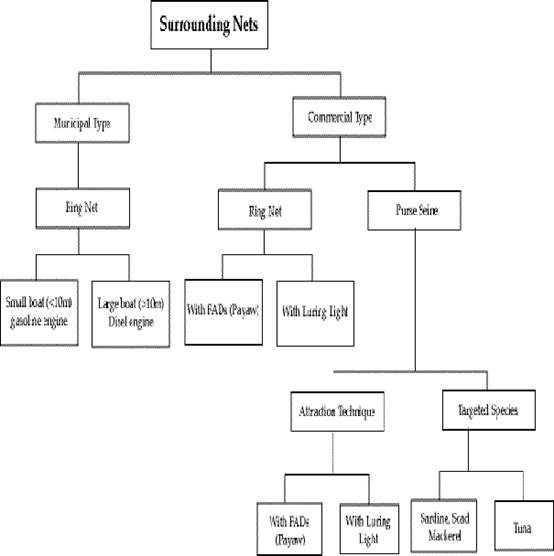Surrounding Nets
Surrounding Net Fishing
Surrounding Net fishing started in the latter part of the 19th century. It evolved from the beach seine which was modified to catch surface dwelling species in deep waters. Initially, the leadline is made much shorter than the float line. With continuing innovations, commercial operation of surrounding net using dugout bancas was introduced in the 1930. It was mechanized, but operation was mostly in shallow waters. The half-ring net was also introduced and operated during the dark phases of the moon.
Modern purse seining was introduced in the 1960, while the traditional ringnet was used primarily in coastal waters. The purse seine is operated using a hydraulic winch, power block and fish finding equipment. The original purse seine net dimension were 348 to 439 m hung length and 64 to 75 m stretched depth. With convincing results of fishing operation, many trawlers were converted into purse seiners in 1964. Its development was further accepted by the private sector with the assistance of the United Nations-Food and Agriculture Organization (UN-FAO) in their special project on Deep-Sea Fishing. Existing net designs were modified and hanging rates were staggered rather than uniform throughout the net. The tapered bottom corner of the net was also introduced. Tuna daytime purse seining in the project was tried, but was not successful.
Eventually, the catching of tuna became successful with the use of ring net/purse seine in small-scale fishing in Cotabato province in 1974. Light attraction and payaws led to increased production. Fishery was accelerated when the South China Sea Development and Coordinating Program of the UN-FAO chartered two (2) Canadian purse seiners. The most productive sets were made with the aid of floating logs, payaws and light attraction. By the middle of 1976, a private fishing company ventured into big scale tuna purse seining. It was so successful that more companies followed its operation. Late in the 1980s, purse seiners increased in number using the latest electronic gadgets such as sonar/fish finders, radar, satellite navigation, and others. Until today, surrounding nets developed rapidly and are still the most productive types of fishing gear for catching pelagic species. They contributed about 68% of the commercial fishery production and 7.0% of the municipal fishery production. It is however noticeable that the production from ringnets in the municipal sector is increasing while the commercial sector shows an increase from 159,270 MT in 1993 to 179,331 MT in 1995. On the other hand, purse seining increased its production in the commercial sector from 425,261 MT in 1993 to 459, 229 MT in 1995 (Table 13).
TABLE 13 MUNICIPAL AND COMMERCIAL FISHERY PRODUCTION OF THE RING NET AND PURSE SEINE, 1993-1995 (METRIC TONS)
Fishing Gear |
1993 |
1994 |
1995 |
Munnicipal |
Commercial |
Munnicipal |
Commercial |
Munnicipal |
Commercial |
| Ring Net |
34,995 |
159,270 |
32,308 |
208,732 |
40,516 |
179,331 |
| Purse Seine |
22,491 |
425,261 |
10,214 |
400,246 |
14,576 |
459,229 |
The major fishing grounds for the ring net and purse seine vary. The ring nets are concentrated in the Bohol Sea, the Moro Gulf, the East Sulu Sea and the South Sulu Sea. The purse seine is operated mostly in west Palawan waters, the South Sulu Sea, the Visayan Sea, the Moro Gulf and Lamon Bay (Table 14). The major species caught are roundscad, sardines, skipjack, frigate tuna and mackerel (Table 15).
TABLE 14 MAJOR FISHING GROUNDS AND PRODUCTION OF COMMERCIAL RING NET AND PURSE SEINE, 1995 (METRIC TONS)
Fishing Grounds |
Ring Net |
Purse Seine |
| West Palawan |
22 |
179,727 |
| South Sulu Sea |
27,086 |
102,392 |
| Visayan Sea |
481 |
71,025 |
| Moro Gulf |
13,204 |
26,406 |
| East Sulu Sea |
13,204 |
1,807 |
| Manila Bay |
13 |
8,236 |
| West Sulu Sea |
3895 |
1,524 |
| Bohol Sea |
61,416 |
2,686 |
| Samar Sea |
9,950 |
773 |
| Lamon Bay |
103,551 |
5,849 |
Source : Fisheries Statistics 1995. BAS
TABLE 15 DOMINANT SPECIES CAUGHT BY MUNICIPAL AND COMMERCIAL RING NET AND PURSE SEINE, 1994-1995 (IN METRIC TONS)
Species |
1994 |
1995 |
Ring Net |
Purse Seine |
Ring Net |
Purse Seine |
| Roundscad |
38,864 |
135,767 |
337,841 |
166,322 |
| Indian Sardines |
39,273 |
96,201 |
36,249 |
106,698 |
| Skipjack |
15,691 |
48,465 |
30,529 |
61,185 |
| Fimbriated Sardines |
6,250 |
12,449 |
8,103 |
14,433 |
| Frigate Tuna |
29,600 |
20,936 |
19,818 |
25,666 |
| Indian Mavkerel |
5,148 |
17,517 |
4,329 |
14,270 |
| Indo-Pacific Mackerel |
4,876 |
7,112 |
2,815 |
8,674 |
| Eastern Little Tuna |
27,430 |
7,885 |
455,338 |
2,675 |
| Big-eyed Scad |
8,216 |
8,773 |
5,981 |
8,927 |
| Slipmouth |
1,565 |
3,226 |
3,313 |
1,819 |
Source : Fisheries Statistics, 1994-1995, Bureau of Agricultural Statistics
Fishing Gear and Methods
Surrounding nets are of two types : the ring net and the purse seine. These are further classified into municipal and commercial types based on attraction techniques, size of boat, and targeted species as shown in the diagram. The municipal type is operated by boats less than 3 Gross tonnage (GT) which may be motorized or non motorized. The commercial type used boats of more than 3 GT. The ring net has its bunt at the center and hauling is done manually by pulling simultaneously both sides of the net. The purse seine has its bunt at one end of the net and hauling is carried out at the opposite end by means of a power block.
Classification of Surrounding Nets

|